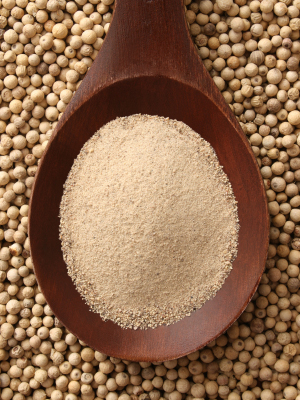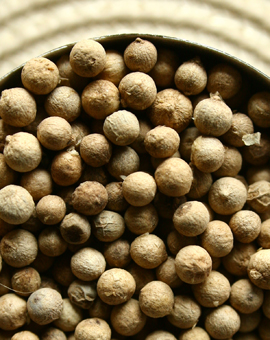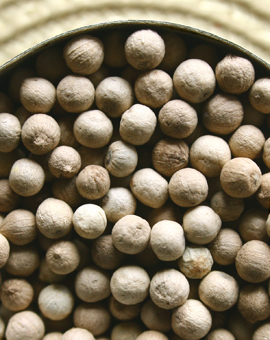 |


White pepper, ground and whole peppercorns. As with black pepper (which is white pepper with the dried fruit skin intact), white pepper from different areas has a distinctly different flavor. Photo by Fotografia Basica | IST. |
| WHAT IT IS: Varietal peppercorns—20 different pepper types and counting. |
WHY IT’S DIFFERENT: Each origin of the world produces pepper with different aromas and flavors—just like coffee beans and chocolate. |
| WHY WE LOVE IT: Another way to vary food accents—and it has no calories! |
| WHERE TO BUY IT: Pepper-Passion.com, Kalustyans.com. |
|
|
 |
 Page 9: White Pepper & Other Pepper Types From T To Z Page 9: White Pepper & Other Pepper Types From T To Z
This is Page 9 of an 11-page article. Here, a variety of different white peppercorns and other peppers of the world. Click on the black links below to visit other pages. Jump to the glossary below.
INDEX
|
Varietal Pepper Glossary T To Z
Talamanca. See black pepper and white pepper, below.
Tasmanian Pepperberry. Tasmannia lanceolata, commonly known as the mountain pepperberry, comes from a shrub native to the rainforest of southeastern Australia. It looks like a Piper nigrum peppercorn, the true peppercorn: dark-blue to black in color with an intense peppery bite. It is fiery: one-tenth the amount of conventional black pepper should be used. Tasmanian pepperberry can be used whole or ground.
Telicherry. See black pepper.
Urfa Biber (or Smoky Turkish Pepper). This spice, like Aleppo pepper, comes from Turkey, near the border of Syria and the Aleppo Valley, and is made from a ground chile pepper. It is deep purple in color with an arresting scent and a smoky, raisin-like flavor (raisin is a note found in ancho and pasilla chiles).
Use It: Traditionally it is used to flavor meat dishes, but it also complements vegetables beautifully. The purple grains make a stunning plate garnish as well: Seek out Urfa Biber for its visual beauty as well as its seasoning contribution.
Vietnam. See black pepper and white pepper, below.
White Peppercorns. Actually beige in color, white pepper is Piper nigrum that is hotter, but less pungent and aromatic, than black pepper. In the U.S. and Continental Europe, white pepper is commonly used for aesthetic reasons: to avoid black flecks interfering with the look of light-colored sauces, soups, beverages, potatoes, fish and chicken dishes. In England and northern Europe, the hotter taste of white pepper is preferred: It outsells black pepper by 10:1. To make white pepper, the Piper nigrum berries are allowed to fully ripen before picking. They then are soaked in water for 48 hours so that the fruit softens and decomposes; any remainder is rubbed off and the naked seed is dried. (Due to the extra processing involved, white pepper is slightly more expensive than black varieties from the same location.) Because the outer layer of dried fruit left on the black peppercorn contains volatile oils, the perfume—the citrusy, woodsy and floral notes of black pepper—is mostly missing in white pepper. However, white pepper can acquire scent from its longer fermentation stage. It is the reduction in aromatics that focuses attention on the flavor and makes the white pepper seems hotter. |
|
 Muntok white peppercorns are more beige in color
Muntok white peppercorns are more beige in color
than the whiter and costlier Sarawak corns. |
- Muntok White Pepper. The most common variety of white pepper, Muntok is grown on the small Indonesian Island of Bangka. They are the Lampong black peppercorn with the dried fruit cover removed. The berries are named after the island’s main port. They are a bit lower in grade than Sarawak, but still have the rich, winey flavor.
Use In: Braises and marinades, instead of the more expensive Sarawak; in soups, on grilled meats and poultry, in light-colored dishes, or mixed with black peppercorns for a more diverse range of flavors.
- Sarawak White Pepper. When you’re going for nuance of flavor, Sarawak, named for the Malaysian province where it is grown, is the top white pepper. Other peppercorns are soaked: Sarawak corns are held under a constantly flowing stream of artesian spring water, yielding a smoother and whiter product. The berries are larger, brigher and more flavorful than Muntok white peppercorns, with a mild, peppery and sweet aroma (somewhat reminiscent of allspice) and a robust, rich, winey/floral flavor. The finish is hot. The shell is thinner and more fragile than Muntok. The price is about double that of Muntok, and according to those who use both, well worth it.
Use In: The same as Muntok, plus in fruit desserts and fine recipes requiring white pepper.
|
|
 Compare the whiteness and cleanness of the Sarawak peppercorns above, with the Muntok corns in the prior photo. Compare the whiteness and cleanness of the Sarawak peppercorns above, with the Muntok corns in the prior photo.
|
- Talamanca Del Caribe White Pepper. Those who like white pepper for its hotness should try this variety from Ecuador. It’s also double the price of basic Muntok.
- Vietnam. Vietnam is now producing high-quality white pepper as well as black. More of it should become arriving in the U.S. Look for it.
Continue To Page 10: Tasting & Comparing Pepper Types
Go To The Article Index Above
Do you have friends who would enjoy THE NIBBLE?
Click here to send them an invitation to sign up for their own copy. |
ABOUT THE NIBBLE. THE NIBBLE™, Great Food Finds™, is an online magazine about specialty foods and the gourmet life. It is the only consumer publication and website that focuses on reviewing the best specialty foods and beverages, in every category. The magazine also covers tabletop items, gourmet housewares, and other areas of interest to people who love fine food.
© Copyright 2004-2025
Lifestyle Direct, Inc. All rights
reserved. All information contained herein is subject to change at any time
without notice. All details must be directly confirmed with manufacturers, service
establishments and other third parties. This material may not
be reproduced, distributed, transmitted, cached, or otherwise used, except with
the prior written permission of Lifestyle Direct, Inc.
|
 |
|
 |







